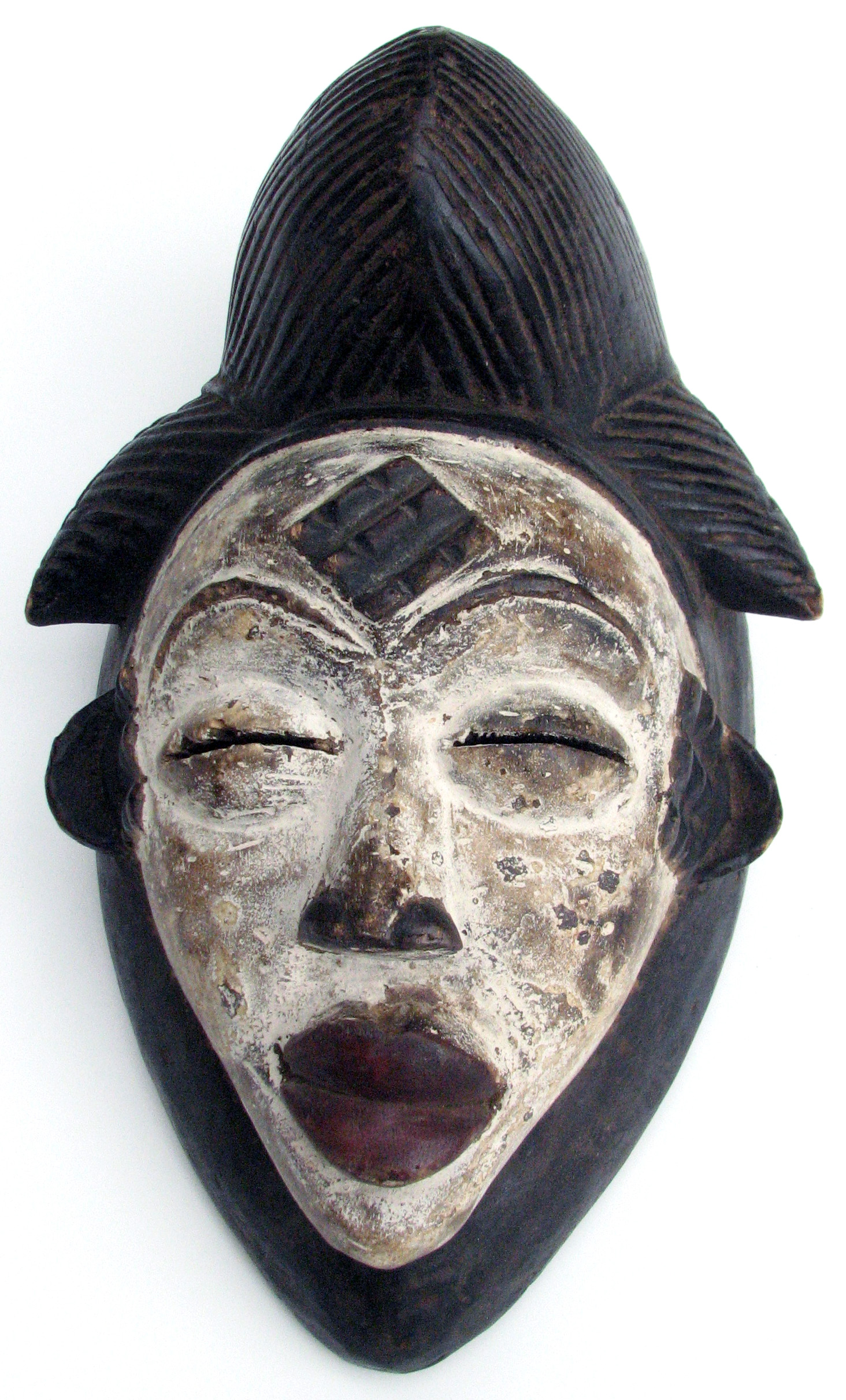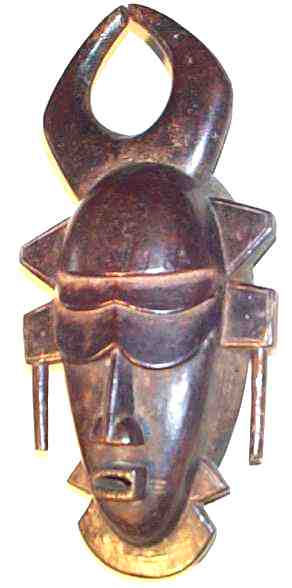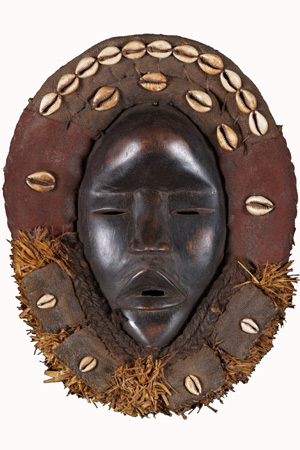 Submitted by Mojo on
Submitted by Mojo on

The creation and history of the African Mask is one steeped in meaning and tradition. The art of carving the African mask was often taught to young men who were apprenticed to master carvers. In other cases, the art of making masks and sculptures to be used in spiritual ceremonies was passed down in families from one generation to the next.
Rich with symbolic meaning, the African mask was treasured for its spiritual quality, as opposed to its aesthetic appearance. People living in different parts of African would produce art unique to their own culture. Here are some fascinating examples:
The Goma Mask
The Goma African mask was produced by people living near Lake Tanganyika, which is located in the Democratic Republic of the Congo. This style of mask is elongated, with a dome at the top of the face. This style of mask also features a pattern of shapes carved into the forehead and face.

The Punu Mask
This style of African mask captures what is considered a beautiful female face by Gabon’s Punu tribe. This style features hair pulled up high on top of the head, with eyes carved in a shape that reminds one of an Asian woman. A Punu mask is sometimes painted white to represent the spirits of long-dead ancestors.

The Ligbi Mask
This celebratory African mask comes from the Ivory Coast. It features an elongated shape with wings on the side. The mouth is carved in the shape of a rectangle. Ligbi masks are used as part of Islamic holiday celebrations.

The Baule Mask
The Baule people carve African masks to be worn while dancing during harvest festivals. The mask’s round shape is a reminder of the Sun, the source of all life. These people respect the tremendous power possessed by the water buffalo which is represented by the horns carved into the top of the mask.
The remarkable thing about the African mask is that each culture has created a unique version to represent the spirit of its tribe. Today westerners appreciate the African Mask for its history, artistry, and ability to represent the owners unique taste and appreciate of diverse cultures.
In Africa, masks can be traced back to well past Paleolithic times. These art objects were, and are still made of various materials, included are leather, metal, fabric and various types of wood.
African Masks are considered amongst the finest creations in the art world and are highly sought after by art collectors. Many of the pieces some replica's, can be viewed in museums and art galleries in many parts of the world. Masking ceremonies in Africa have great cultural and traditional significance. Latest developments and understanding of Aesthetic principles, religious and ceremonial values, have brought about a greater insight into the ideas and moral values that African artists express in their art.
During celebrations, initiations, crop harvesting, war preparation, peace and trouble times, African Masks are worn by a chosen or initiated dancer. It can be worn in three different ways: vertically covering the face: as helmets, encasing the entire head, and as crest, resting upon the head, which was commonly covered by material as part of the disguise. African Masks often represent a spirit and it is strongly believed that the spirit of the ancestors possesses the wearer.
Ritual ceremonies generally depict deities, spirits of ancestors, mythological beings, good and or evil, the dead, animal spirits, and other beings believed to have power over humanity. Masks of human ancestors or totem ancestors (beings or animals to which a clan or family traces its ancestry) are often objects of family pride; when they are regarded as the dwelling of the spirit they represent, the masks may be honored with ceremonies and gifts.
During the mask ceremony the dancer goes into deep trance, and during this state of mind he "communicate" with his ancestors. A wise man or translator sometimes accompanies the wearer of the mask during the ritual. The dancer brings forth messages of wisdom from his ancestors. Often the messages are grunted utterances and the translator will accurately decipher the meaning of the message. Rituals and ceremonies are always accompanied with song, dance and music, played with traditional African musical instruments.
For thousands of years, rituals and ceremonies was and to a lesser extent is still an integral part of African life. The gradual, effects of parceled out territories to Colonial governments, and the ensuing damage to traditional economies followed by the displacement of huge quantities of people, by colonialism, resulted in economies and food production systems being wrecked. In general the vast number of people have lost some of its tribal identity and culture, hence masking ceremonies are no longer common place in Africa.

What are those leather pouches around that warrior’s arm? Those sacks tied around a young woman’s waist? The scrolls inside a West African silver ring? A ju-ju, or “supernatural object,” is a type of West African charm attributed with magical powers. Still widely crafted today, West Africans within many countries still practice superstitious beliefs that lead them to wear and adorn their homes and children with tokens of good fortune and health. |
To some, ju-ju making is a form of witchcraft, but as part of everyday life even for urban and well-educated West Africans, it is a more serious tradition rooted deeply in many cultures. Even university professors are seen today wearing ju-jus underneath their clothing, and it has been an explosive area of curiosity for researchers, volunteers and tourists to the region.
While some African cultures still believe in the spiritual nature of items such as cowrie shells, most ju-jus are intentionally crafted objects blessed with incantations or containing inserted Arabic scripts. The most common crafters of ju-jus are marabouts, who place the scripts inside a necklace, bracelet, ring or other pouch and sew it shut tightly. These West African marabouts are often referred to by outsiders as “witch-doctors,” and they earn a living exclusively from the local people who seek out his services.
While many West Africans employ the marabout to make healing ju-jus, there are many other types of ju-jus. Scripts can be written with the hope of certain marriage arrangements, agricultural harvests, business transactions and even bad omens upon enemies. Ju-Jus are also commonly requested by wives and mothers seeking a spiritually-accepted form of birth control.
Outside of West Africa, many escaped slaves in the Caribbean and America continue the practice of making ju-jus, although the separation of time and geography have caused differences in the ritual ju-ju making and their intentions.
In addition to the very real practice of wearing ju-jus, many African masks and African sculptures are adorned with these curious embellishments. Often mistaken as simple accessory or jewelry, a studied eye will recognize the significance of a ju-ju adorning a mask or sculpture within his collection.
Most figures and sculptures of West African warriors, for example, will include different types of ju-jus hanging around the neck, as an armband or even at the waist. Although more rare, there are types of African masks where ju-jus will grace the forehead or ears of the figure. It is considered quite taboo to open a juju and read the script inside, and often the passage time mixed with the cryptic hand-scribed Arabic letters would only offer a small insight into how and why a particular ju-ju was created–letting the mysterious quality of the object be the most alluring part.
http://www.afrikboutik.com/wordpress/the-spiritual-history-of-the-african-mask/
- 40713 reads